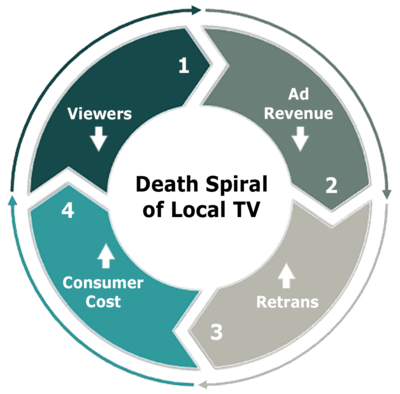

By Robert Bishop
Whether you are the part of Utah that has access to local television or the part that doesn’t, you can let your voice be heard.
Local TV Builds Community
Did you know that the only way residents of Alpine, Utah can get local television reception is to subscribe to a pay-TV service like cable or satellite? Ten years ago, residents could get local TV free over-the-air using an antenna—but not after they moved the transmission tower. Did you know the same is true for many other parts of Utah, especially rural Utah? Today, local TV reaches fewer and fewer people.
In its heyday, 95% of US households had access to local TV. As of 2022, 53% have either left cable or satellite pay-TV or never had it. Cord-cutters say it’s too expensive. Younger, cord-nevers only know streaming. And, cord-cant’s have no antenna reception.
Many Utahns who don’t have local TV get their information from social media platforms which polarize and divide the public through disinformation and manipulation and are controlled by individuals with personal agendas. The simple fact is that we need more community and less meddling. Local TV programming builds community in a way that social media cannot.
2024 should be a banner year for Utah’s local TV stations. Thanks to Jazz owner, Ryan Smith, all non-nationally televised Utah Jazz games will be broadcast over the airwaves on KJZZ-TV; local, state, and presidential elections will be covered by all of Utah’s network affiliates; and the 33rd Summer Olympics in France will be broadcast in July and August 2024 through our local NBC affiliate KSL-TV. However, the truth is that no matter where you live, local stations are headed for a cliff.
How Did We Get Here?
Broadcasters use public airwaves at no cost on the condition that local TV channels be broadcast for free. That’s the deal. When cable was deregulated in the 1970s, cable companies began charging subscribers for local TV channels along with other channels in various programming packages. Later the FCC required that cable companies pay a retransmission fee to include local TV channels.
These monthly retransmission fees have skyrocketed more than 8,000% in the last decade or so (e.g., $0.25 per household to $20). Over time, consumers have become confused and frustrated with the cost of TV.
With the proliferation of the internet and the invention of streaming, other options for TV entertainment have become available. As streaming services ballooned, national broadcasters turned their attention to paid streaming platforms like Peacock TV and Paramount+. These paid initiatives bypass their local affiliates.
It's interesting to note that adaptive bit-rate streaming which is used by essentially everyone to stream video on the Internet (e.g., YouTube, Disney/Hulu, Netflix, and others) was invented by Drew Major, a native and lifelong resident of Utah.
Can It Be Saved?
 Here’s the conundrum: With fewer viewers, local TV ad revenues decline. Local channels prop up the loss with increases in monthly retransmission fees (e.g., with each retransmission “renegotiation,” distributors come to the table with fewer viewers yet local broadcasters demand higher rates). These increases are then margined and passed down to subscribers. The higher costs create more cord-cutters and time passing creates more cord-nevers as youth become adults. And the cycle repeats over and over. It’s not sustainable.
Here’s the conundrum: With fewer viewers, local TV ad revenues decline. Local channels prop up the loss with increases in monthly retransmission fees (e.g., with each retransmission “renegotiation,” distributors come to the table with fewer viewers yet local broadcasters demand higher rates). These increases are then margined and passed down to subscribers. The higher costs create more cord-cutters and time passing creates more cord-nevers as youth become adults. And the cycle repeats over and over. It’s not sustainable.
This was clearly demonstrated in July 2023 when Nexstar Media Group forced the nation’s largest local TV outage after demanding more than double the current viewer fees from DirecTV. This affected 68% of all DirecTV households in the U.S. Not surprisingly, DirecTV capitulated shortly after the NFL season began. However, during this 76-day feud consumers were locked out from receiving the local channels they pay for. As expected, a few weeks after the new agreement, DirecTV announced new, higher pricing across the board—for the second time this year. How messed up is that?
What Do Broadcasters Say?
The TV broadcast industry has been touting ATSC-3, an updated over-the-air TV standard, as a possible solution but the signal is not backward compatible and would have the same limitations in terms of reach that we currently have. How can anyone expect the over-the-air crowd to run out and purchase a new TV? I don’t know about you but my crystal ball says that by the time they implement this—if they ever do—the whole thing will be moot. Paid Internet streaming will have won. LG announced that they are going to stop making ATSC-3 compatible TVs. Samsung and Sony may not be far behind. Vizio was never on board.
There have been a few attempts to modernize free consumer access to local TV and each ended in a burned-out cinder from lawsuits. It’s not that the national networks don’t see the problem. It’s that they have chosen to focus on their own paid streaming platforms and not local broadcasters. It’s not that local broadcasters don’t see the cliff. It’s that they're stuck in the mindset of ever-increasing retransmission fees as the solution.
Personally, I hope this gets resolved before it’s too late. I’d really be sad to say goodbye to local TV and the community ties that it builds. On the other hand, social media icons Elon Musk and Mark Zuckerberg—and probably the national TV networks—would probably love it if we just stayed the course.
What Can Be Done?
I’ve spoken with several state legislators and state officials about these issues. The consensus in all of these conversations is that local TV should remain free and be accessible to all Utahns no matter where they live. What do you think would happen if everyone had unfettered access to local TV for free and our local broadcaster’s audience size suddenly got a whole lot bigger? Do you think that might keep them from going over the cliff?
Fair Use Disclaimer: The use of the image from the 1991 film (partly filmed in Utah) Thelma and Louise, falls under the Fair Use Act Title 17, Section 107 of the United States Code of the US United States Copyright law in the context of news reporting, one of the accepted uses of copyrighted material. The image in the header of the article is used to illustrate a metaphor mentioned in the article.

